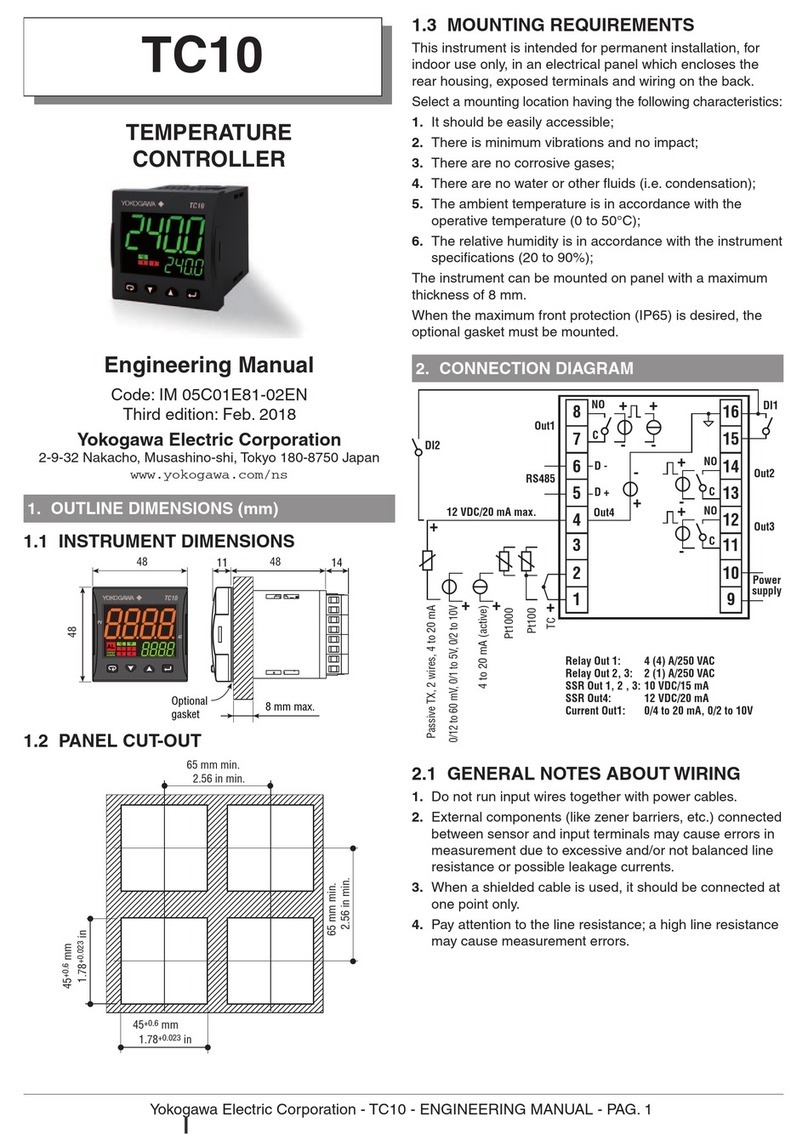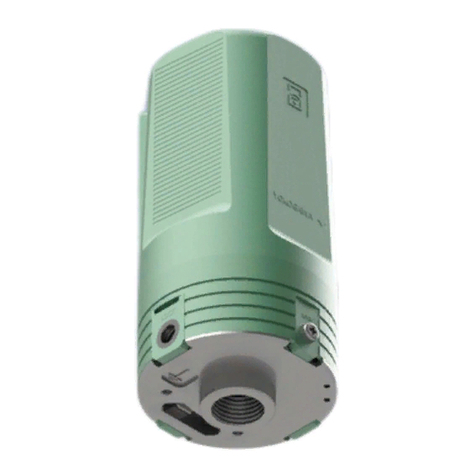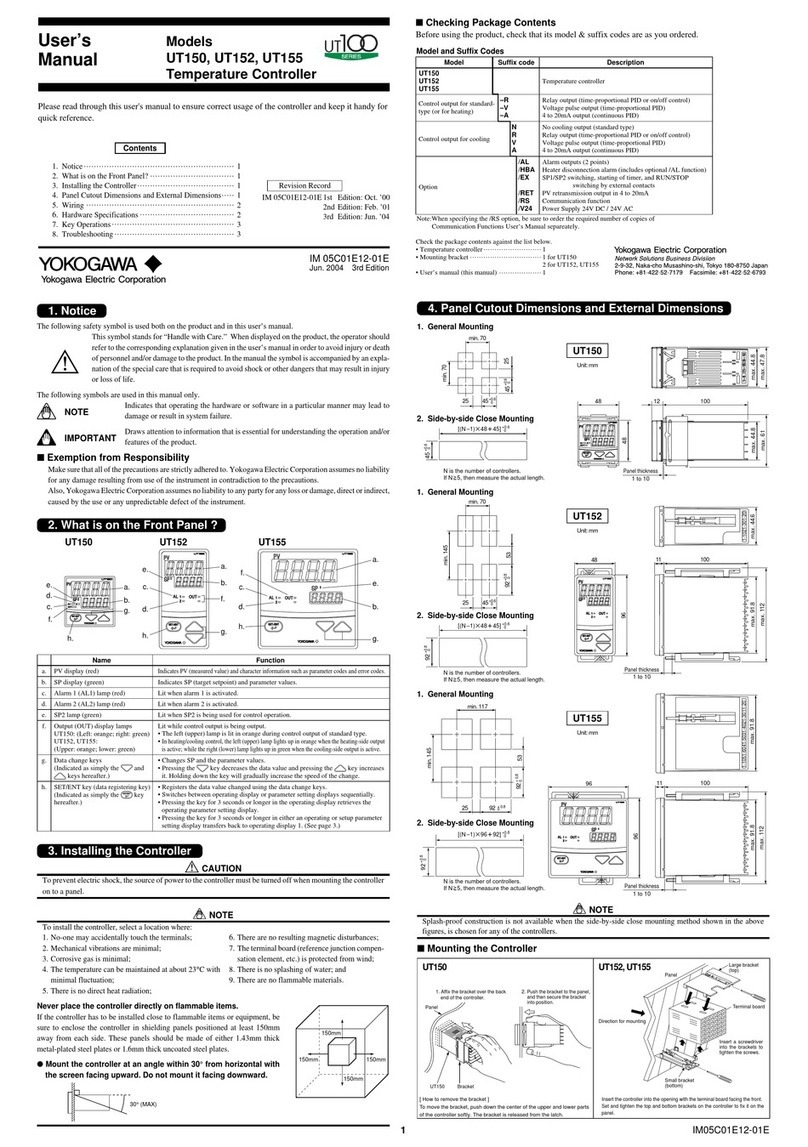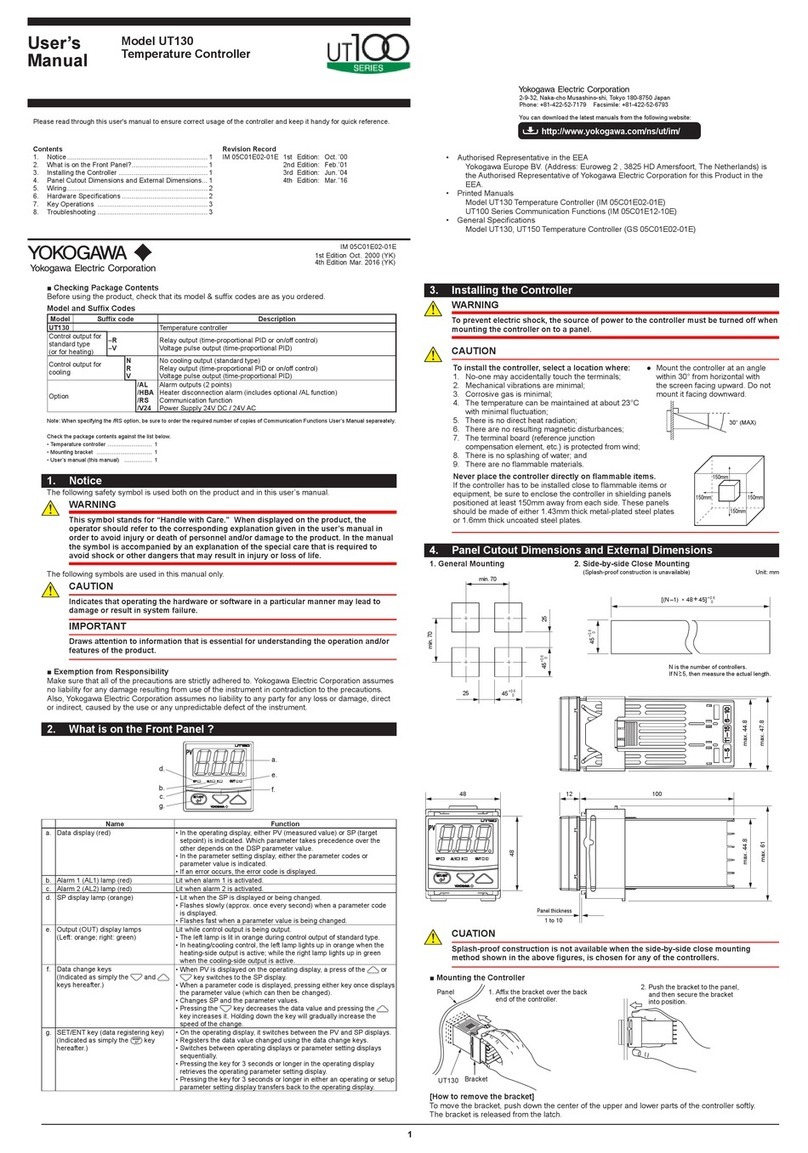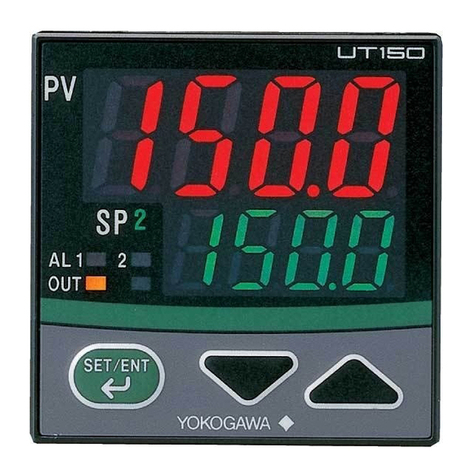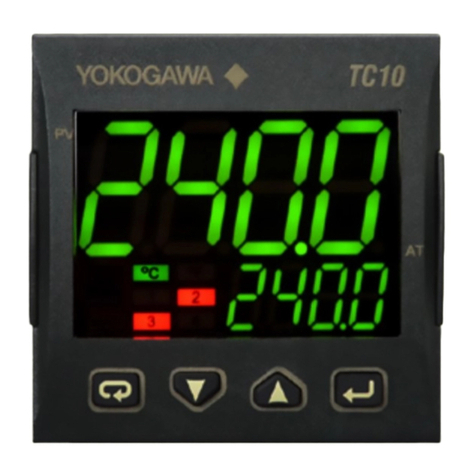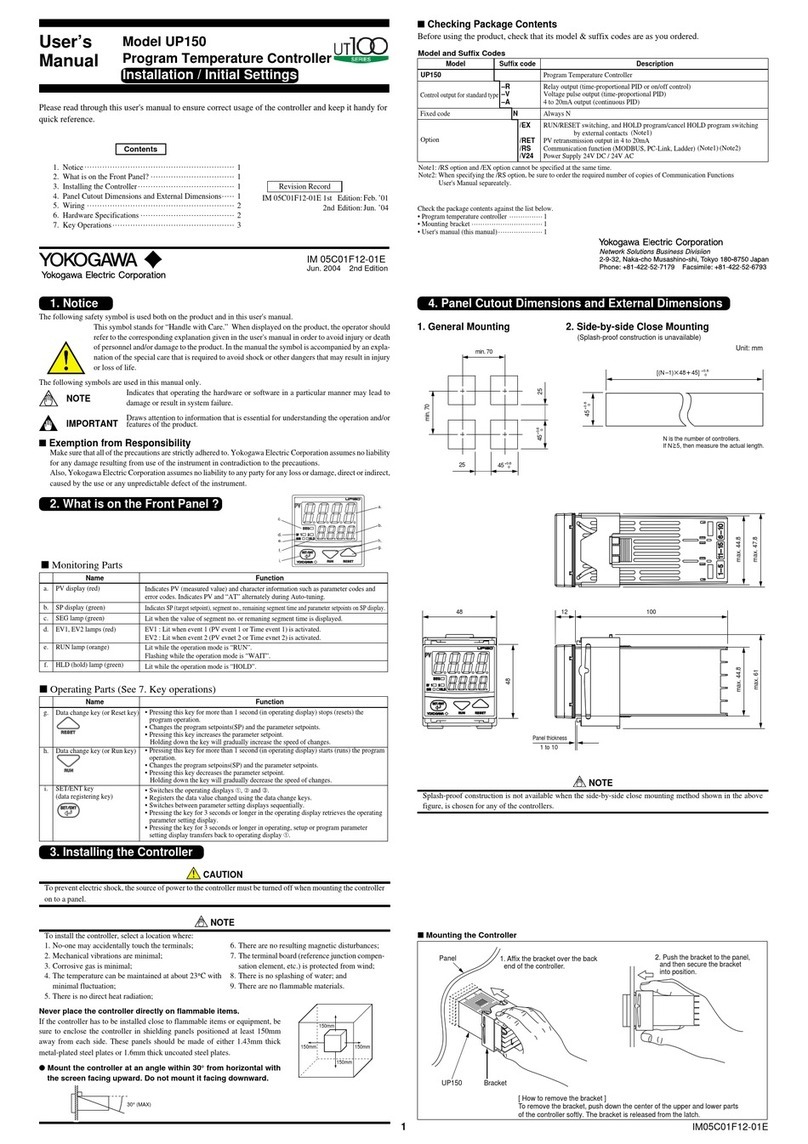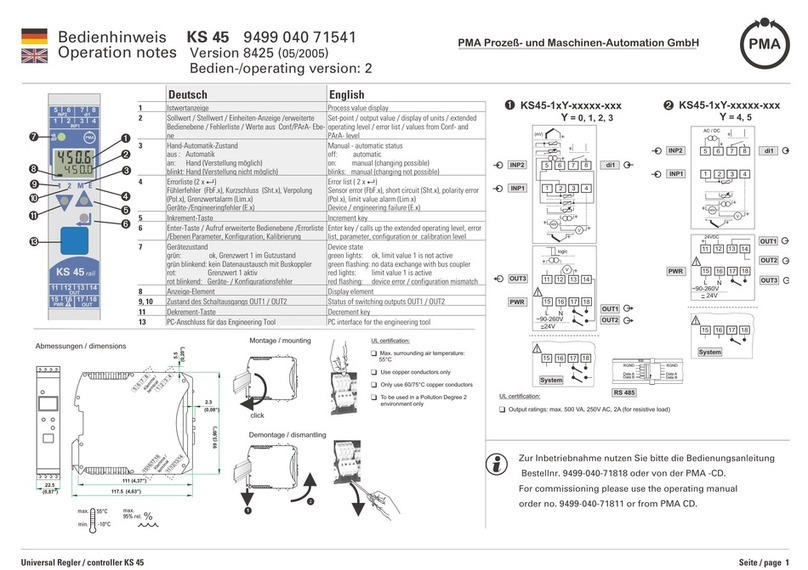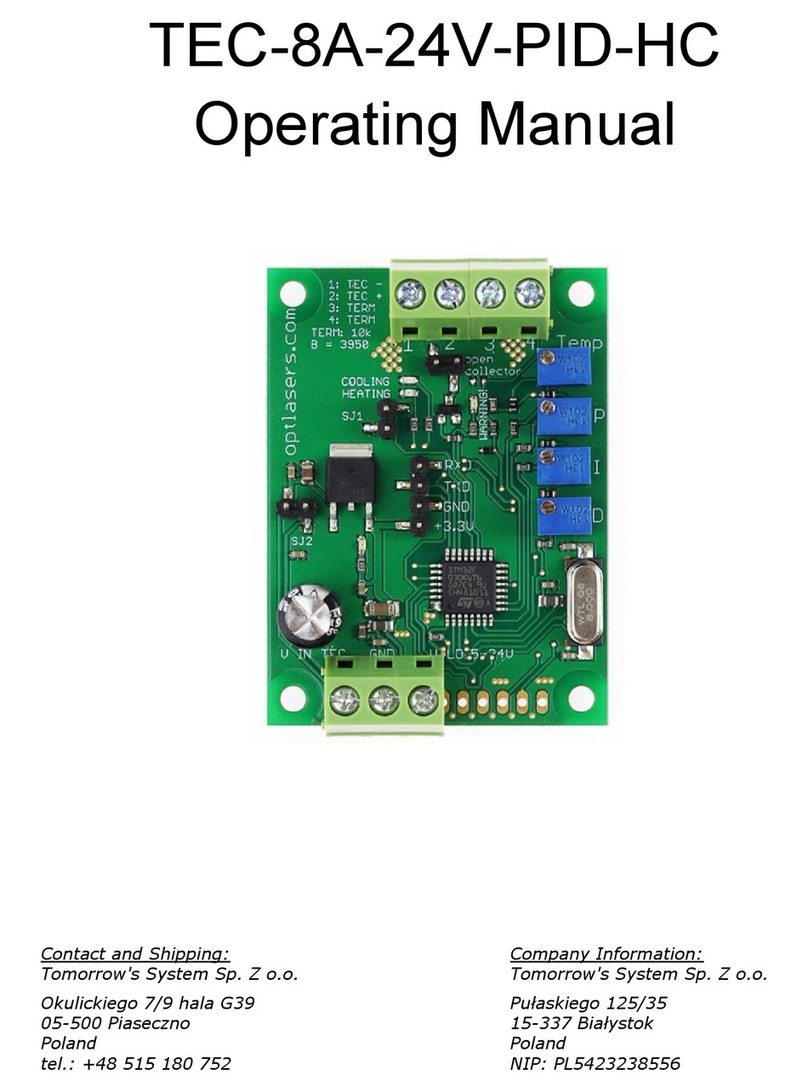
2
IM05F01F12-01E
● Cable Specifications and Recommended Products
● Recommended Terminals
Use M3.5 screw-compatible crimp-on terminals with an insulating sleeve, as shown below.
Power supply and relay contact output 600V vinyl insulated wire/cable, JIS C3307, 0.9 to 2.0mm2
Shielded wire (3-wire), UL2482 (Hitachi cable)
Thermocouple input Shielded compensating lead wire, JIS C1610
RTD input
Other signals Shielded wire
7mm or less
7mm or less
ø3.7mm ø3.7mm
CAUTION
1) Before you start wiring, turn off the power source and use a tester to check that the instrument and cables are
not receiving any power in order to prevent electric shock.
2) For safety, be sure to install a circuit breaker switch (of 5A and 100V AC or 220V AC, and that conforms to
IEC60947) near the instrument so as to be operated easily, and clearly indicate that the device is used to de-
energize the instrument.
3) Wiring should be carried out by personnel with appropriate electrical knowledge and experience.
NOTE
1) Use a single-phase power source. If the source has a lot of noise, use an isolation transformer for the primary
side and a line filter (we recommend TDK’s ZAC2205-00U product) for the secondary side. When this
noise-prevention measure is taken, keep the primary and secondary power cables well apart. Since the
manual setter has no fuse, be sure to install a circuit breaker switch (of 5A and 100V AC or 220V AC, and
that conforms to IEC standards) and clearly indicate that the device is used to de-energize the manual setter.
2) For thermocouple input, use shielded compensating lead wires. For RTD input, use shielded wires which
have low resistance and no resistance difference between the 3 wires. See the table given later for the
specifications of the cables and terminals and the recommended products.
3) The alarm output relay cannot be replaced even though it has a limited service life (100,000 relay contacts
for the resistance load). Thus, an auxiliary relay should be used so that the load can be turned on and off.
4) When using an inductive load (L) such as an auxiliary relay and solenoid valve, be sure to insert a CR filter
(for AC) or diode (for DC) in parallel as a spark-rejecting surge suppressor to prevent malfunctions or
damage to the relay.
5) When there is the possibility of being struck by external lightening surge, use the arrester to protect the
instrument.
5. Wiring
1
2
3
4
5
6
7
8
9
10
11
12
13
14
15
ALM2
ALM1
COM
Alarm Outputs
11
12
13
Manual Setting (SP) Output
■Model UD310-00 Terminal Arrangement
Power Supply
9L
N
10
100-240V AC
9
10
AC/DC 24V
+
–
CAUTION
To prevent damage to the manual setter,
never provide 100-240V AC power supply
for power supply AC/DC 24V model (when
⬙/V24⬙is specified).
NOTE
The and stand for the polarity
for DC 24V power supply.
+–
NOTE
Do not use unassigned terminals as relay terminals.
NOTE
Do not use unassigned terminals as relay terminals.
TC Input RTD Input
7
8
6
7
8
+
–
B
b
A
Universal input-selectable
input type
DC mV or V Input
7
8
+
–
Measured Value (PV) Input
■Models UD320-00/UD350-00 Terminal Arrangement
PV Retransmission Output
+
–
1
2
4 to 20 mA DC
4 to 20 mA Output
14
15
+
–
when /V24 option is specifed.
11
29
30
12
13
14
15
16
17
18
19
20
26
27
28
PV Retransmission Output
+
–
29
30
ALM2
ALM1
COM
Alarm Outputs
16
17
18
Manual Setting (SP) Output
4 to 20 mA Output
14
15
+
–
TC Input RTD Input
12
13
11
12
13
+
–
B
b
A
Universal input-selectable
input type
DC mV or V Input
12
13
+
–
Measured Value (PV) Input
CAUTION
To prevent damage to the manual setter,
never provide 100-240V AC power supply
for power supply AC/DC 24V model (when
⬙/V24⬙is specified).
NOTE
The and stand for the polarity
for DC 24V power supply.
+–
Power Supply
19 L
N
20
100-240V AC
19
20
AC/DC 24V
+
–
when /V24 option is specifed.
Note:The terminal arrangements of the UD320 and UD350 are the same.
7
8
Note: Connecting a 250 Ωresistor to the terminals is
optional.
Model: X010-250-2 (resistor with M3.5 crimp-on terminal
lugs)
* When receiving 4-20 mA DC current signals,
set the PV input type to 1-5 V DC (setpoint “22”).
Receiving 4-20 mA DC Current
Signals with the Manual Setter
250 Ω4-20mA
-
+
12
13
Note: Connecting a 250 Ωresistor to the terminals is
optional.
Model: X010-250-2 (resistor with M3.5 crimp-on terminal
lugs)
* When receiving 4-20 mA DC current signals,
set the PV input type to 1-5 V DC (setpoint “22”).
Receiving 4-20 mA DC Current
Signals with the Manual Setter
250 Ω4-20mA
-
+
4 to 20 mA DC
6. Hardware Specifications
•
Input: 1 point
•
Input type: Universal; can be selected by software
•
Input accuracy (at 23 ±2°C ambient temperature)
•Thermocouple: ±2°C ±1digit
However,
•
±4°C for thermocouple input –200 to –100°C
•
±3°C for thermocouple input –100 to 0°C
•
±5°C for types R and S (±9°C for 0 to 500°C)
•
±9°C for type B
(accuracy is not guaranteed for 0 to 400°C)
•RTD: ±1°C ±1digit
•Voltage(mV, V) : ±0.3% ±1digit
•
Sampling period for measured value input: 500ms
•
Burn-out detection: Functions for thermocouple or RTD input
(burn-out upscale only; cannot be switched off)
•
Input resistance: 1MΩor greater for thermocouple
or DC mV input. Approx. 1MΩfor DC V input
•
Maximum allowable signal source resistance :
250
Ω
for thermocouple or DC mV input
2k
Ω
for DC V input
•
Maximum allowable wiring resistance for RTD input:
10Ω/wire (The resistance values of three wires must be the same.)
•
Allowable input voltage: ±10V DC for thermocouple or DC mV input
±20V DC for DC V input
•
Noise rejection ratio:
Normal mode noise: Min. 40dB
(50/60Hz)
Common mode noise: Min. 120dB
(Min. 90dB for DC V input)
•
Error of reference junction compensation:±1.5°C (at 15-35°C)
±2.0°C (at 0-50°C)
The reference junction compensation cannot be switched off.
•
Applicable standards:
Thermocouple and resistance temperature detector(RTD)
JIS/IEC/DIN (ITS90)
SP (target setpoint) will be output in 3 seconds
after the change.
•
Output: 1 point
•
Output type: Current output
Output signal: 4 to 20mA
current output
Maximum load resistance: 600Ω
Output accuracy: ±0.3% of span
(at 23±2°C ambient temperature)
Measured Value (PV) Input Alarm Functions
Manual Setting (SP) Output
•
Output signal: Measured value in 4-20mA DC,
can be scaled.
•
Maximum load resistance: 600Ω
•
Output accuracy: ±0.3% of span
(at 23±2°C ambient temperature)
Retransmission Output
•
Safety: Compliant with IEC/EN61010-1: 2001,
approved by CSA1010, approved by UL508.
Installation category : CAT. II (IEC/EN61010,
CSA1010) Pollution degree : 2
(IEC/EN61010, CSA1010)
Measurement category : I
(CAT. I : IEC/EN61010)
Rated measurement input voltage : 10V DC
max.(across terminals), 300V AC max.(across
ground)
Rated transient overvoltage : 1500V (Note)
Note : It is a value on the safety standard
which is assumed by IEC/EN61010-1 in
measurement category I, and is not the value
which guarantees an apparatus performance.
Caution: This equipment has Measurement
category I, therefore do not use the equipment
for measurements within measurement
categories II, III and IV.
•
EMC standards: Complies with EN61326.
The instrument continues to o
erate at a
measurin
accurac
of within
2
% of the
ran
e durin
tests
Safety and EMC Standards
■Normal Operating Conditions
•
Warm-up time: At least 30 minutes
•
Ambient temperature:0-50°C (0-40°C when
mounted side-by-side)
•
Rate of change of temperature: 10°C/h or less
•
Ambient humidity: 20-90% RH (no condensation allowed)
•
Magnetic field: 400A/m or less
•
Continuous vibrations of 5 to 14Hz: Amplitude of 1.2mm or less
•
Continuous vibrations of 14 to 150Hz: 4.9m/s
2
(0.5G) or less
•
Short-period vibrations: 14.7m/s
2
(1.5G) for 15 seconds or less
•
Shock: 98m/s
2
(10G) for 11 milliseconds or less
•
Mounting angle: Upward incline of up to 30
degrees; downward incline is not allowed.
•
Altitude: 2000m or less above sea level
■
Maximum Effects from Operating Conditions
(1) Temperature effects
•
Thermocouple, DC mV and DC V input: ±2µV/°C
or ±0.02% of F.S./°C, whichever is larger
•
Resistance temperature detector: ±0.05°C/°C
•
Analog output: ±0.05% of F.S./°C
(2) Effect from fluctuation of power supply voltage
(within rated voltage range)
•
Analog input: ±0.2µV/V or ±0.002% of F.S./V,
whichever is larger
•
Analog output: ±0.05% of F.S. /V
■
Transportation and Storage Conditions
•
Temperature: –25 to 70°C
•
Humidity: 5 to 95% RH (no condensation allowed)
•
Shock: Package drop height 90cm (when packed in
the dedicated package)
Environmental Conditions
■
Alarm Functions
•
Alarm types: 22 types
(waiting action can be set by software):
PV high limit, PV low limit, Deviation high
limit, Deviation low limit, De-energized on
deviation high limit, De-energized on deviation
low limit, Deviation high and low limits,
Deviation within high and low limits, De-
energized on PV high limit, De-energized on
PV low limit, Fault diagnosis output, FAIL
output
•
Alarm output: 2 relay contacts
Relay contact capacity: 1A at 240V AC or 1A
at 30V DC (with resistance load)
(COM terminal is common)
Note: The alarm output relays cannot be replaced by users.
Construction, Mounting, and Wiring
•
Construction: Dust-proof and drip-proof front
panel conforming to IP65 [Model UD310] and
IP55 [Models UD320 and UD350].
For side-by-side close installation the controller
loses its dust-proof and drip-proof protection.
•
Casing: ABS resin and polycarbonate
•
Case color: Black
•
Weight: UD310 - approx. 200g
UD320 - approx. 300g
UD350 - approx. 400g
•
Mounting: Flush panel mounting
•
Wiring: Screw terminals
Power Supply and Isolation
■
Power Supply
Note 1:
The primary terminals are the power supply terminals and
alarm output terminals.
The secondary terminals are the analog input and output terminals.
Note 2: AC/DC 24V terminals are secondary terminals.
Maximum power consumption
Voltage
Frequency
Between primary terminals
and secondary terminals
(See Notes 1 and 2.)
Between primary terminals
and secondary terminals
(See Notes 1 and 2.)
50 or 60Hz
Non-volatile memory
1500V AC
for 1 minute
20MΩor more at
500V DC
Memory
Withstanding
voltage
Insulation
resistance
Power
supply
Rated at 100-240VAC (±10%)
AC/DC 24V, 20 to 29V of
allowable range when
⬙/V24⬙is specified.
8VA max. (4W max.)
3W max. when
⬙/V24⬙is specified.
■ Isolation
The bold lines below indicate reinforced isolation, and
the broken line indicates functional isolation.
Note: The measured value input terminals is isolated from the
internal circuit.
•
Measured value input
terminals
•
Internal circuit
•
Alarm output
terminals
(2 relay contacts)
•
Manual setting output
terminals :
4-20 mA
•
Retransmission output
terminals :
4-20 mA
•
Power supply
terminals
(100-240V AC)
•
Power supply
terminals AC/DC 24V
(When ⬙/V24⬙is specified)
1
2
3
4
Measurement category
CAT.1
CAT.2
CAT.3
CAT.4
R
m
rk
Appliances, portable equipments, etc.
Distribution board, circuit breaker, etc.
Overhead wire, cable systems, etc.
Description
For measurements performed on circuits not directl
connected to MAINS
For measurements performed on circuits directly connected to the low voltage installation.
For measurements performed in the building installation.
For measurements performed at the source of the low-voltage installation.
Internal Wirin
Entr
n
abl
IMPORTANT
Two types of optional anti-electric-shock terminal covers (part numbers T9115YE and T9115YD) are available
for the UD320 and UD350 manual setters, respectively.
IMPORTANT
Always fix a terminal cover bracket to the UD310 manual setter before wiring if an optional anti-electric-shock
terminal cover (part number: L4000FB) is used.

